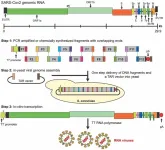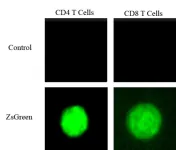(Press-News.org) PITTSBURGH — Contraceptive use is low among reproductive-aged people with disabilities who are enrolled in Medicare, according to a new study from the University of Pittsburgh that highlights how lack of contraceptive coverage by Medicare may prevent disabled enrollees from accessing contraception.
Published today in the January issue of Health Affairs, the study provides the first national overview of contraceptive use among enrollees in Medicare, the government health insurance for people over 65 and for people with qualifying disabilities. The researchers say that policy changes are needed to expand contraception coverage in Medicare and to ensure more equitable health care for people with disabilities, who already face barriers to reproductive health care and have higher rates of pregnancy complications and deaths than nondisabled people.
“The federal government requires that commercial insurers and Medicaid cover all contraceptive methods without cost sharing, but there is no similar requirement for Medicare, which means that disabled enrollees may not be able to access contraception or their preferred method of contraception,” said lead author Jacqueline Ellison, Ph.D., M.P.H., assistant professor in the Department of Health Policy and Management at the Pitt School of Public Health. “People with disabilities are already marginalized and experience barriers to accessing health care. It is unjust that they face additional cost-related barriers to receiving their contraceptive method of choice.”
Medicare does not require coverage for contraception to prevent pregnancies but may cover certain contraceptives for clinical indications such as endometriosis. Oral contraception may also be covered by Part D, an optional drug coverage benefit that costs extra. Patients may also be covered for other contraceptive methods by enrolling in Medicare Advantage, which is provided by private companies that contract with Medicare, but the scope of coverage depends on the company.
This complicated insurance landscape means that people with disabilities may not be able to access contraception or may be forced to pay out of pocket to access their preferred method of contraception.
In 2019, Medicare was the primary health insurance coverage for about 1.38 million reproductive-aged females with disabilities: About 941,000 had traditional Medicare and about 444,000 had Medicare Advantage. To understand more about patterns of contraceptive use among this population, Ellison and her team used two databases of insurance claims to analyze a study sample representing 17.2% of traditional Medicare and 9.5% of Medicare Advantage populations.
The researchers found that contraceptive use was low among reproductive-aged females with disabilities. Just 14.3% of traditional Medicare enrollees and 16.3% of those with Medicare Advantage had an insurance claim for contraception in 2019. In comparison, another study found that about 25% of reproductive-aged females with Medicaid — which is required to cover all forms of contraception — had such a claim in 2018.
The analysis also showed variation in contraceptive methods by type of Medicare coverage. For example, Medicare Advantage enrollees were about four times more likely to use an intrauterine device and 10 times more likely to have tubal ligation than those with traditional Medicare.
“This variation isn’t due to patient preference: There’s no reason that people with Medicare Advantage would be so much more likely than those with traditional Medicare to prefer using the intrauterine device or undergoing tubal sterilization,” explained Ellison. “This is a function of Medicare not requiring coverage for the full range of contraceptive methods.”
Medicare enrollees with noncontraceptive indications — such as acne, endometriosis, menstrual pain and irregular bleeding — were nearly twice as likely to use contraceptives as those without such an indication. This finding may highlight the importance of contraceptives for reasons beyond pregnancy prevention, or it may reflect clinicians documenting such an indication to help their patients get contraception when they otherwise would not have coverage.
“People with disabilities are more vulnerable to interference by guardians and clinicians in their reproductive decision making,” said Ellison. “It’s critical that, while ensuring access to the full range of contraceptive methods, we protect people with disabilities against such interference by ensuring contraceptive care provided in the Medicare program is truly person-centered.”
Other authors on the study were Sabnum Pudasainy, M.S., Deirdre Quinn, Ph.D., M.P.H, Sonya Borrero, M.D., M.S., Iris Olson, M.P.H., Qingwen Chen, M.S., and Marian Jarlenski, Ph.D., M.P.H., all of Pitt; and Meghan Bellerose, M.P.H., and Theresa I. Shireman, Ph.D., of Brown University.
This research was supported by the National Institute for Reproductive Health (5717077).
END
Study highlights barriers to contraceptive access for disabled Medicare enrollees
2024-01-08
ELSE PRESS RELEASES FROM THIS DATE:
Study of national data demonstrates the value of acute hospital care at home
2024-01-08
Since the Centers for Medicare and Medicaid Services launched the Acute Hospital Care at Home (AHCaH) Waiver in 2020, thousands of patients from across 300 hospitals in 37 states have been treated in their homes. Yet little is understood about these patients’ outcomes on a national level, and the waiver will end in December 2024 unless there is an act from Congress. A new study by investigators from Mass General Brigham analyzed outcomes from AHCaH for a diverse group of patients across America. The study provides preliminary evidence suggesting that home hospital ...
Hospital care at home benefits medically complex, socially vulnerable patients
2024-01-08
Embargoed for release until 5:00 p.m. ET on Monday 8 January 2024
Annals of Internal Medicine Tip Sheet
@Annalsofim
Below please find summaries of new articles that will be published in the next issue of Annals of Internal Medicine. The summaries are not intended to substitute for the full articles as a source of information. This information is under strict embargo and by taking it into possession, media representatives are committing to the terms of the embargo not only on their ...
Real-world analysis: COVID-19 vaccine strongly effective for children and adolescents during delta and omicron
2024-01-08
Children and adolescents who received one of the main COVID-19 vaccines were significantly protected from the illness and showed no increased signs of cardiac complications compared to young people who were not vaccinated, according to a new real-world study led by researchers from the Perelman School of Medicine at the University of Pennsylvania and Children’s Hospital of Philadelphia (CHOP). When the Delta variant rose to prominence, the study showed that vaccinated young people were 98 percent less likely to be infected than their unvaccinated peers, and ...
Studying cells to improve medulloblastoma treatment
2024-01-08
Research is shedding light and potentially expanding options for patients living with Medulloblastoma, an aggressive childhood cancer.
Medulloblastoma is a cancer impacting both very young and school aged children.
When children get this type of brain tumor, they experience the process of the tumor blocking flow of fluid around the brain.
This can cause severe headaches, vomiting, sleepiness, fussiness, and difficulty walking and coordinating movements.
Treatment is intense, involving high dose chemotherapy, surgery, and sometimes radiation or stem cell transplants.
During these months long treatments, children may lose ...
Residential addiction treatment for U.S. teens is scarce, expensive
2024-01-08
Despite an alarming increase in overdose deaths among young people nationwide, a new “secret shopper”-style study led by Oregon Health & Science University researchers finds that access to residential addiction treatment centers for adolescents in the United States is limited and costly.
The study, published today in the January issue of the journal Health Affairs, found that about half of the sites reported a wait time, and among those the average wait was almost a month. For those who do manage to find a placement, the average daily cost is $878 — with close to half of the facilities that provided information requiring partial or full payment upfront. For the average ...
Residential addiction treatment for adolescents is scarce and expensive
2024-01-08
Access to residential addiction treatment centers caring for U.S. adolescents under 18 years old in the United States is limited and costly, according to a new study supported by the National Institutes of Health. Researchers found that only about half (54%) of the residential addiction treatment facilities that they contacted had a bed immediately available, and for those that had a waitlist, the average estimated time before a bed opened was 28 days. In addition, the average daily cost per day of treatment was $878, with close to half (48%) of the facilities that provided information requiring partial or full payment upfront. ...
Transformation-associated recombination (TAR) cloning and its applications
2024-01-08
“TAR cloning is used to genetically engineer synthetic viruses with novel properties that may be used for the development of new vaccines.”
BUFFALO, NY- January 8, 2024 – A new review paper was published in Oncotarget's Volume 14 on December 22, 2023, entitled, “Transformation-associated recombination (TAR) cloning and its applications for gene function; genome architecture and evolution; biotechnology and biomedicine.”
Transformation-associated recombination (TAR) cloning represents a unique tool to selectively and efficiently recover a given chromosomal segment up to several hundred ...
Slow the scroll: Users less vigilant about misinformation on mobile phones
2024-01-08
UNIVERSITY PARK, Pa. — Mobile phones pack a lot of information into pocket-sized devices, which is why users may want to slow down the next time they’re scrolling through social media or checking email on a mobile app. People process information more efficiently but tend to be less vigilant about misinformation on their mobile phones compared to personal computers (PCs), according to a team led by Penn State researchers. This is especially true for users who have developed a routine or habit of using their ...
Researchers at UMass Amherst shed light on how tumor cells outwit the body’s immune system
2024-01-08
AMHERST, Mass. – In a first-of-its-kind research breakthrough, a team of scientists at the University of Massachusetts Amherst has analyzed and described what they call the “mosquito effect,” which sheds light on how certain pathogens, such as cancerous tumor cells, can outwit the body’s immune system.
Just as mosquitoes ingest their host’s blood, the immune system’s T cells incorporate cytoplasmic material from tumors into their own cytoplasm. While it has long been known that many kinds of cells can transfer cellular material from one to another, the transfer of the cytoplasm has never been observed in T cells. Subsequent single-cell RNA (scRNA) ...
New soft robots roll like tires, spin like tops and orbit like moons
2024-01-08
Researchers have developed a new soft robot design that engages in three simultaneous behaviors: rolling forward, spinning like a record,and following a path that orbits around a central point. The device, which operates without human or computer control, holds promise for developing soft robotic devices that can be used to navigate and map unknown environments.
The new soft robots are called twisted ringbots. They are made of ribbon-like liquid crystal elastomers that are twisted – like a rotini ...



